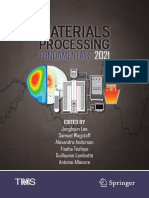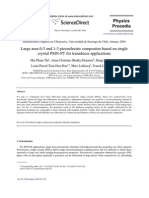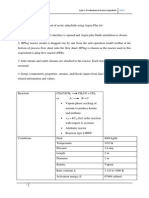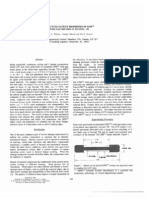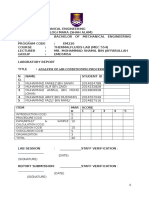SU-8 Plasma Etching
SU-8 Plasma Etching
Uploaded by
กวาง นาโนวCopyright:
Available Formats
SU-8 Plasma Etching
SU-8 Plasma Etching
Uploaded by
กวาง นาโนวOriginal Description:
Original Title
Copyright
Available Formats
Share this document
Did you find this document useful?
Is this content inappropriate?
Copyright:
Available Formats
SU-8 Plasma Etching
SU-8 Plasma Etching
Uploaded by
กวาง นาโนวCopyright:
Available Formats
DTIP 2003, Mandelieu La Napoule, France, 5-7 May 2003, pp.
268-271
SU8 RESIST PLASMA ETCHING AND ITS OPTIMISATION
Guodong Hong, Andrew S Holmes, Mark E Heaton Optical & Semiconductor Devices Group Department of Electrical & Electronic Engineering Imperial College Exhibition Road, London SW7 2BT UK
ABSTRACT The thick photoresist SU8, by virtue of its good mechanical durability, water impermeability and dielectric properties on polymerisation, is widely used as a resin for making high aspect ratio, functional MEMS device structures and packaging parts. However, the difficulty associated with removal, stripping or repatterning of the polymerised SU8 remains a serious issue. This paper presents a novel process, based on O2/SF6 plasma etching, for patterning or removal of fully cross-linked SU8. The Taguchi methodology is used to optimise the O2/SF6 mix for a high etch rate and low under cut. 1. INTRODUCTION The negative, epoxy-based photoresist SU8 has been used extensively as a resin for making high aspect ratio MEMS (Micro-Electro-Mechanical Systems) device structures and packaging parts, by virtue of its good mechanical properties [1], water impermeability and dielectric nature on polymerisation. A principle application of SU8 is in the making of electroplating molds [2][3], injection molding masters and embossing masters [4][5] for structures with high aspect ratio. Owing to its biocompatibility and chemical resistance, SU8 is also ideally suited to the fabrication of micro-channels for microfluidic and bioMEMS devices [6]. Recently, polymerised SU8 has found further applications in the fabrication of mechanically functional structures, such as gears and resonant components within MEMS devices [7][8]. Unfortunately, the chemical and mechanical properties of fully cross-linked SU8 that make it so attractive as a functional material for MEMS also make it difficult to remove or strip by conventional means when used as a mold material. For example, the usual commercial stripper, hot NMP (1-methyl-2pyrrolidinone), simply softens the polymer to a gel-like consistency rather than dissolving it, and this can result in lifting off of fine structures when large areas of resist become separated from the substrate. Other wet chemical agents, such as oxidizing mixtures of sulphuric acid and hydrogen peroxide (typically 3:1 H2SO4:H2O2) offer better stripping [9], but are inappropriate in many applications because they also tend to attack metal structures. This paper presents a novel O2/SF6 plasma etching method to remove or pattern fully cross linked SU8. It is well known that oxygen plasma etching can strip most solidified photoresists. It has also been shown previously that stripping rates can be enhanced when fluorinated gases are added to the oxygen plasma [10]. Even a small percentage of fluorinated gas can bring about a large increase in the removal rate for many resists because (1) fluorine atomic reactions produce reactive sites on the polymer backbone, and (2) small amounts of fluorine increase the concentration of atomic oxygen in the plasma. In this work we have optimised an SU8 plasma etching process using oxygen, sulfur hexafluoride (SF6) and argon as the etching gases, with chamber base pressure and individual gas flow rate set as control factors. 2. DESIGN OF EXPERIMENTS AND THE TAGUCHI METHOD When optimising a process that depends on several factors (controllable process variables), the range of possible processes increases exponentially with the number of variables. Thus, the traditional factorial method of optimising a process by changing each factor in turn until all possibilities have been tested is an approach that can rapidly become too time-consuming or expensive to implement. Also, the importance of each process variable in determining the final output may not be seen with this approach.
Level 1 2 3
Flow rate of O2 (sccm) 20 40 60
Table 1 Flow rate of SF6 (sccm) 0 3 6
Flow rate of Ar (sccm) 0 10 20
Pressure (mT) 50 100 150
Using the Taguchi method [11][12] one can solve the above problems effectively by conducting experiments using the orthogonal array technique to determine the experiments, and the Analysis of Variance (ANOVA) method to interpret the results. Even over a large number of process variables, relatively few experiments are necessary to see the importance of each variable in the final output. In our experiments, four variables, three of flow rate - for oxygen, SF6 and argon - and one of chamber pressure, were selected to maximise the etching rate and minimise undercut. In this case a three-level L9(34) orthogonal array can be used to study the effect of all four variables. The etch rate and undercut were assessed using a stylus profilometer and an SEM (scanning electron microscope). Based on some preliminary experiments, the range and levels of the variables were set as shown in table 1. 3. SAMPLE PREPARATION AND EXPERIMENTS All experiments were carried out on quarter sections of 3 diameter silicon wafer having a native oxide layer. The SU8 was first spin-coated onto the substrate to form a resist layer of approximately 100 microns thickness. The resin was then processed with the standard procedure of pre-baking on a hotplate at 90 C for 30 minutes, followed by exposure to UV light at an intensity of 10 mW/cm2 for 10 minutes. The sample was then baked on a hotplate at 90 C for 30 minutes, before finally being hard baked in an oven at 170 C for 60 minutes and slowly cooled to room temperature. By this stage the SU8 resist was fully cross-linked. In preparation for reactive ion etching, a metal etch mask was defined on each sample. First, a conducting seed layer (300 Cr for adhesion, followed by 2000 Cu) was deposited by sputter coating. An electroplating mold was defined by photolithography in a 2 m-thick layer of Shipley S1813 photoresist, and the sample was electroplated with nickel to a depth of about 5 microns. The S1813 resist mold and seed layer were stripped using acetone, aluminium etch (for the copper) and a commercial Cr etchant.
A series of etching experiments, conducted according to an L9 (34) orthogonal array, was carried out on a Plasma-Lab PC-5100 reactive ion etcher (Plasma Technology(UK) Ltd). The temperature of the plasma etching table was kept at 10 C, and the forward and reflected powers were maintained at 200 W and zero respectively. After 20 minutes plasma etching, the metal mask was stripped with a 1M FeCl3 solution, and the depth of the etched structures was measured with a surface profilometer (Dektak 3ST, Sloan Technology). Undercut was calculated as the difference between the widths of the etched structures and the corresponding mask apertures, as measured by the surface profilometer. Analysis of variance (ANOVA) was used to interpret the experimental results and decide on the optimum level of each factor. Finally, a separate test was performed to verify the results obtained with the proposed optimum parameter settings. 4. ANALYSIS OF RESULTS After the measurements of etch depth and undercut were gathered, the mean depth and undercut at each level was calculated for every variable, in accordance with the Taguchi method. Figure 1 shows, for each of the four variables, the mean etch depth obtained at each of the 3 levels. The peak-to-peak variations in mean etch depth for the four variables (O2 flow, SF6 flow, Ar flow and pressure) are 0.89, 3.52, 1.26 and 1.86 respectively. Thus the most important variable for etch rate is SF6 flow rate, followed by chamber pressure and Ar/O2 flow rate. From Fig 3(b) it can also be seen that the mean etch depth is greatest when the SF6 flow rate is at level 2. This suggests that small amounts of SF6 can greatly increase the plasma etching rate over that obtained with a pure O2 or O2/Ar plasma. Figure 3(d) shows that higher chamber pressures bring about a greater contribution to the mean etch depth, as would be expected. Based on the analysis above, we can say the best plasma parameter combination is O2 = 60 sccm, SF6 = 3 sccm, Ar = 0 sccm, and chamber pressure = 150 mT. To verify this prediction, a second series of optimisation experiments for etch rate was done on another RIE machine (RIE 80, Plasma Technology). In the verification experiments, a fifth variable, the etching power, was also
7 Mean Etch Depth (m) 6 5 4 3 20 40 60 Flow rate of O2 (sccm)
7 6 5 4 3 0 3 6 Flow rate of SF6 (sccm)
7 6 5 4 3 0 10 20 Flow rate of Ar (sccm)
7 6 5 4 3 50 100 Pressure (mT) 150
(a)
(b)
(c)
(d)
Figure 1. Sensitivity analysis for etch rate.
3 Mean Undercut (m) 2 1 0 20 40 60 Flow rate of SF6 (sccm) Flow rate of Ar (sccm) Pressure (mT) Flow rate of O2 (sccm)
(a)
(b)
(c)
(d)
Figure 2. Sensitivity analysis for undercut.
considered. All five variables were varied at 4 levels. So a L16(45) orthogonal array was used. These experiments yielded similar results to those obtained with the PC5100. Around the best level of each variable shown in figure 1, further experiments were conducted to fine tune the optimisation. As a result of this process the best parameters for SU8 etching were set at O2 = 50 sccm, SF6 = 2 sccm, Ar = 0 sccm and chamber pressure = 150 mT. At these levels SF6 accounts for about 4-5 % of the etch gas mixture by volume. The etch rate also depends on the loading effect of the sample and the machine type and configuration. For our experiments, where the etched area was about 20-30 % of the total area, the etching rate was about 1.5-2 microns per minute in the RIE80 machine. Figure 2 shows the mean undercut obtained at each level for each of the four process variables. It can be seen all 4 variables have a small variation in their mean undercut. The peak-to-peak variation is 0.77 for the flow rate of O2, 1.25 for the flow rate of SF6, 1.19 for the flow rate of Ar, and 1.65 for the chamber pressure. Thus the chamber pressure is more important than the other variables, but the difference is not significant. From figures 2(c) & 2(d), it can be seen that higher flowrates of Ar and lower chamber pressures can reduce the etching undercut. This is in conflict with the optimisation of the etch rate. Consequently there is a trade-off in situations where the SU8 is going to be patterned by plasma etching and both high etch rate and small undercut are needed. Experiments on deep SU8 patterning by RIE show the undercut is unavoidable. Argon can reduce the undercut, but its improvement is limited. Figure 3 shows examples of SU8 structures with undercut patterned by plasma etching.
(a)
(b)
Figure 3. SU8 structures etched by O2/SF6 plasma through a nickel mask.
5. CONCLUSIONS A dry etching method for removing or patterning polymerised SU8 potoresist, based on plasma etching with a mixture of O2 and SF6, has been optimised by the Taguchi method. Experimental analysis shows that pure oxygen plasmas etch SU8 only very slowly, while adding even a small amount of SF6 can dramatically increase the etching rate. For our etching system, the optimal SF6/O2 mixture contains about 5 % SF6 by volume, and gives an etch rate of about 1.5-2 microns per minute. Argon has been shown to reduce slightly the undercut and side wall slope for etched structures, while also reducing the etch rate. 6. REFERENCES
[1] H. Lorenz, et al, Mechanical Characterization of a new high-aspect-ratio near UV-photoresist, Microelectron. Eng. 41/42, pp. 371-374, 1998. [2] L.J. Guerin, et al, High aspect ratio planar coils embedded in SU8 photoepoxy for MEMS applications, EuroSensor98, pp. 11-14, 1998. [3] V. Seidemann et al, A novel fabrication process for 3D meander shaped micro coils in SU8 dielectric and their application to linear micro motors, Proc SPIE Conf on Microelectronics and MEMS Technologies, SPIE 4407, pp. 304-309, 2001. [4] H. Lorenz et al, Fabrication of photoplastic high aspect ratio microparts and micromolds using SU8 UV reist, Microsyst. Technol. 4, pp. 143-146, 1998.
[5] J. Zhang et al, Polymerization Optimization of SU-8 Photoresist and Its Applications in Microfludic Systems and MEMS, J. Micromech. Microeng. 11, pp 20-26, 2001. [6] Che-Hsin Lin et al, A new fabrication process for ultrathick microfluidic microstructures utilizing SU-8 photoresist, J. Micromech. Microeng. 12, pp. 590-597, 2002. [7] V. Seidemann et al, SU8-micromechancial structures with in situ fabricated movable parts, Microsystem Technologies 8, pp. 348-350, 2002. [8] E.H. Conradie et al, SU-8 thick photoresist processing as a functional material for MEMS applications, J. Micromech. Microeng. 12, pp. 368-374, 2002. [9] Chien-Hung Ho et al, Ultrathick SU-8 mold fabrication and removal, and its application of LIGA-like micromotors with embedded roots, Sensors and Actuators A, 102, pp. 130-138, 2002. [10] D.M. Manos et al, Plasma Etching: An Introduction, Academic Press, Inc. 1988, London, UK, pp. 167-170. [11] K. Dehnad, Quality Control, Robust Design, and the Taguchi Method , Pacific Grove, Calif. : Brooks/Cole Pub. Co, 1988. [12] D.C. Montgomery, Design and Analysis Experiments, New York ; Chichester : Wiley, 1997. of
You might also like
- Case Lufthansa 2000 - Analysis and ConclusionDocument15 pagesCase Lufthansa 2000 - Analysis and ConclusionTao Hemberg Jankel100% (2)
- Analyzing Architecture: Laurie Baker Loyola Chapel, TrivandrumDocument2 pagesAnalyzing Architecture: Laurie Baker Loyola Chapel, TrivandrumSalman LatiwalaNo ratings yet
- 517 141Document11 pages517 141sorincarmen88No ratings yet
- Mazda 32318 I 16 VBPDocument49 pagesMazda 32318 I 16 VBPJon Luc Pulido Julian0% (2)
- Vrancken-RAPDASA (2015) Influence of Preheating and Oxygen Content On Selective Laser Melting of Ti6Al4VDocument10 pagesVrancken-RAPDASA (2015) Influence of Preheating and Oxygen Content On Selective Laser Melting of Ti6Al4VRama BalharaNo ratings yet
- 8) Ch3 Exp. Work 16-2-2017Document15 pages8) Ch3 Exp. Work 16-2-2017amnajamNo ratings yet
- The Effects of Argon and Oxygen Plasmas On The Surface Morphology of Polysulfone MembraneDocument5 pagesThe Effects of Argon and Oxygen Plasmas On The Surface Morphology of Polysulfone MembraneSupaporn YuenyaoNo ratings yet
- Numerical Investigation and Comparison With Experimental Characterisation of Side Gate P-Type Junctionless Silicon Transistor in Pinch-Off StateDocument5 pagesNumerical Investigation and Comparison With Experimental Characterisation of Side Gate P-Type Junctionless Silicon Transistor in Pinch-Off Statesaeid59No ratings yet
- Ni-Co Alloy Electroplating For MemsDocument7 pagesNi-Co Alloy Electroplating For MemsIsman KhaziNo ratings yet
- Tangsopha 2017Document4 pagesTangsopha 2017Đăng PhạmNo ratings yet
- Mafra 2023Document8 pagesMafra 2023marciomafraNo ratings yet
- Stankovic09 PieselParticulateFiltersDocument5 pagesStankovic09 PieselParticulateFiltersEl SebastianNo ratings yet
- Effect of The MgO Substitution For CuO On The Properties of CaCu3Ti4O12 CeramicsDocument8 pagesEffect of The MgO Substitution For CuO On The Properties of CaCu3Ti4O12 CeramicsAlan MartinsNo ratings yet
- Thesis Gas SensorDocument6 pagesThesis Gas SensorFindSomeoneToWriteMyCollegePaperUK100% (2)
- Case Study: Wear in Supersonic Nozzle of Tip Lance in Vallourec Brazil SteelmakingDocument15 pagesCase Study: Wear in Supersonic Nozzle of Tip Lance in Vallourec Brazil Steelmakingwillian limaNo ratings yet
- Boldyrev - Tunel de Vento HipersônicoDocument5 pagesBoldyrev - Tunel de Vento HipersônicoalexandreburanNo ratings yet
- MRAM EtchingDocument7 pagesMRAM EtchingKarthik GopalNo ratings yet
- Materials Development On The Nanoscale by Accumulative Roll Bonding ProcedureDocument4 pagesMaterials Development On The Nanoscale by Accumulative Roll Bonding ProcedureBruno MouraNo ratings yet
- Metathesis of 1 Butene and 2 Butene To Propene Over Re2O7 Supported On Macro Mesoporous Alumina Prepared Via A Dual Template Method 2012 Journal of NaDocument4 pagesMetathesis of 1 Butene and 2 Butene To Propene Over Re2O7 Supported On Macro Mesoporous Alumina Prepared Via A Dual Template Method 2012 Journal of NaaegosmithNo ratings yet
- 2021reynolds TMS2021Document11 pages2021reynolds TMS2021viweqhubinkomoNo ratings yet
- 2013-High Cycle Fatigue (HCF) Performance of Ti-6Al-4V Alloy Processed by Selective Laser MeltingDocument6 pages2013-High Cycle Fatigue (HCF) Performance of Ti-6Al-4V Alloy Processed by Selective Laser Melting王重睿No ratings yet
- FEM Modelling of TSRST Specimen Test-Istanbul, PosterDocument11 pagesFEM Modelling of TSRST Specimen Test-Istanbul, Posteradnan qadirNo ratings yet
- Material Properties of Ti6Al4V Parts Produced by Laser Metal DepositionDocument9 pagesMaterial Properties of Ti6Al4V Parts Produced by Laser Metal DepositionEmoke JozsaNo ratings yet
- A New Insight On The Analysis of Residual Stresses Related Distortions in Selective Laser Melting of Ti-6Al-4V Using The Improved Bridge Curvature MDocument16 pagesA New Insight On The Analysis of Residual Stresses Related Distortions in Selective Laser Melting of Ti-6Al-4V Using The Improved Bridge Curvature MPaul HealyNo ratings yet
- Ai Apl#241143Document15 pagesAi Apl#241143Anonymous UJFK2jk5gNo ratings yet
- Preparation of Plasma-Polymerized SiOx-like Thin Films From A MixtureDocument6 pagesPreparation of Plasma-Polymerized SiOx-like Thin Films From A MixturekgvtgNo ratings yet
- Simulations of A Cavity Based Two-Dimensional Scramjet ModelDocument4 pagesSimulations of A Cavity Based Two-Dimensional Scramjet ModelKummitha Obula ReddyNo ratings yet
- The in Uence of Silicate-Based Nano-Filler On The Fracture Toughness of Epoxy ResinDocument10 pagesThe in Uence of Silicate-Based Nano-Filler On The Fracture Toughness of Epoxy Resineid elsayedNo ratings yet
- Surface-Step-Induced Magnetic Anisotropy in Epitaxial LSMO Deposited On Engineered STO SurfacesDocument10 pagesSurface-Step-Induced Magnetic Anisotropy in Epitaxial LSMO Deposited On Engineered STO SurfacesTom TaylorNo ratings yet
- Creep Behavior of Eutectic 80Au20Sn Solder Alloy PDFDocument4 pagesCreep Behavior of Eutectic 80Au20Sn Solder Alloy PDFeid elsayedNo ratings yet
- Development of A Phase Diagram To Control Composite: Manufacturing Using Raman SpectrosDocument11 pagesDevelopment of A Phase Diagram To Control Composite: Manufacturing Using Raman SpectrosAkhil ModiNo ratings yet
- 14 V 149 GDocument12 pages14 V 149 GJherson NietoNo ratings yet
- Esa2012 S5Document7 pagesEsa2012 S5Ram RanjanNo ratings yet
- Photochemical Machining of SS304Document9 pagesPhotochemical Machining of SS304atul_saraf001No ratings yet
- Large Area 0-3 and 1-3 Piezoelectric Composites Based On Single Crystal PMN-PT For Transducer ApplicationsDocument8 pagesLarge Area 0-3 and 1-3 Piezoelectric Composites Based On Single Crystal PMN-PT For Transducer ApplicationsAmir JoonNo ratings yet
- Multi-Response Optimization of PTA Welding Parameter For Overlay Process of Stellite 6B On Duplex Stainless Steel Using Taguchi MethodDocument4 pagesMulti-Response Optimization of PTA Welding Parameter For Overlay Process of Stellite 6B On Duplex Stainless Steel Using Taguchi MethodBrajendra PatelNo ratings yet
- 02.02 Jui-Chin Chen Wen-T English PDFDocument8 pages02.02 Jui-Chin Chen Wen-T English PDFMaged AbbasNo ratings yet
- EIS Studies of A Corrosion Inhibitor Behavior Under Multiphase Ow ConditionsDocument12 pagesEIS Studies of A Corrosion Inhibitor Behavior Under Multiphase Ow Conditionsgoogley71No ratings yet
- Parametric Study of Dry WEDM Using Taguchi Method: S.Boopathi, K.Sivakumar, R.KalidasDocument6 pagesParametric Study of Dry WEDM Using Taguchi Method: S.Boopathi, K.Sivakumar, R.KalidasIJERDNo ratings yet
- Ultrasonic Measurements of Solid Propellant Burning Rates in Nozzleless Rocket MotorsDocument8 pagesUltrasonic Measurements of Solid Propellant Burning Rates in Nozzleless Rocket MotorsSharat ChandraNo ratings yet
- DeterioraçãoDocument11 pagesDeterioraçãoGustavo PamplonaNo ratings yet
- Dense Si N Coatings With High Friction Coefficient Deposited by High-Velocity Pulsed Plasma SprayingDocument8 pagesDense Si N Coatings With High Friction Coefficient Deposited by High-Velocity Pulsed Plasma SprayingVincenzo PilusoNo ratings yet
- 03 Catalyst CharacterizationDocument39 pages03 Catalyst CharacterizationMegan TorresNo ratings yet
- Chuang Et al-2019-JOM PDFDocument10 pagesChuang Et al-2019-JOM PDFJorge SanchezNo ratings yet
- Membrane SeparationDocument12 pagesMembrane Separationchemicaly12No ratings yet
- 1.0 Procedure: Lab 4: Production of Acetic AnhydrideDocument9 pages1.0 Procedure: Lab 4: Production of Acetic AnhydrideHoneydaa Fitra100% (2)
- A Finite Element Model For TBC Damage Detection and Lifetime PredictionDocument12 pagesA Finite Element Model For TBC Damage Detection and Lifetime Predictionklomps_jrNo ratings yet
- Life - Time - Analysis - of - Mcraly - Coatings - For - Industrial - Gas - Turbine - Blades - (Calculational - and - Experimental - Approach)Document22 pagesLife - Time - Analysis - of - Mcraly - Coatings - For - Industrial - Gas - Turbine - Blades - (Calculational - and - Experimental - Approach)Rafael Garcia IllescasNo ratings yet
- Microwave Properties of Spinal FerriteDocument5 pagesMicrowave Properties of Spinal FerriteInternational Journal of Application or Innovation in Engineering & ManagementNo ratings yet
- Inconel 738 PropiedadesDocument9 pagesInconel 738 PropiedadesEmad A.AhmadNo ratings yet
- Natural Mineral Fire Retardant Fillers For PolyethyleneDocument10 pagesNatural Mineral Fire Retardant Fillers For Polyethylenegusanito09No ratings yet
- Sensors and Actuators B: ChemicalDocument7 pagesSensors and Actuators B: ChemicalFamiloni LayoNo ratings yet
- Models - Cfd.pem ElectrolyzerDocument46 pagesModels - Cfd.pem ElectrolyzerLại Thế KhánhNo ratings yet
- AI-APL#241143 EditedDocument17 pagesAI-APL#241143 EditedAnonymous UJFK2jk5gNo ratings yet
- Journal of Chemical EnggDocument10 pagesJournal of Chemical EnggJayamPandiNo ratings yet
- Nanostructured Cobalt Zinc Ferrite Thin Films For Gas Sensor ApplicationDocument10 pagesNanostructured Cobalt Zinc Ferrite Thin Films For Gas Sensor ApplicationInternational Journal of Innovative Science and Research TechnologyNo ratings yet
- Approved Few P&Bits R&Taassj: Disirlbböesi UsDocument231 pagesApproved Few P&Bits R&Taassj: Disirlbböesi UsEne FlorinNo ratings yet
- Research Article: Comparison of Nondestructive Testing Methods On Detection of Delaminations in CompositesDocument8 pagesResearch Article: Comparison of Nondestructive Testing Methods On Detection of Delaminations in CompositesFofaSistaNo ratings yet
- Cavitation Prediction of Flow Over The Delft Twist 11 FoilDocument9 pagesCavitation Prediction of Flow Over The Delft Twist 11 FoilMNirooeiNo ratings yet
- Lab Compresible Flow.Document17 pagesLab Compresible Flow.AlifZaidi100% (1)
- Bensouda 2018Document24 pagesBensouda 2018Adrian RosasNo ratings yet
- The Chemistry of Membranes Used in Fuel Cells: Degradation and StabilizationFrom EverandThe Chemistry of Membranes Used in Fuel Cells: Degradation and StabilizationShulamith SchlickNo ratings yet
- Employee Attitude and Their EffectsDocument13 pagesEmployee Attitude and Their EffectsKartikesh VashisthaNo ratings yet
- English Term Paper TopicsDocument6 pagesEnglish Term Paper Topicsfuhukuheseg2100% (2)
- Blood Stain Analysis LabsDocument27 pagesBlood Stain Analysis LabsGee Dinero0% (1)
- Clutch Problems 332Document3 pagesClutch Problems 332Nova April100% (2)
- Cosmonate PH Mdi PureDocument3 pagesCosmonate PH Mdi PureOnesany TecnologiasNo ratings yet
- Digital Predistorters Go Multidimensional DPD For Concurrent Multiband Envelope Tracking and Outphasing Power AmplifiersDocument12 pagesDigital Predistorters Go Multidimensional DPD For Concurrent Multiband Envelope Tracking and Outphasing Power AmplifiersMuhammad HaiderNo ratings yet
- EEDP Lect 06 Amplifiers 3 ClassesDocument20 pagesEEDP Lect 06 Amplifiers 3 Classesbaburao_kodavatiNo ratings yet
- Biomedical Ktu EceDocument34 pagesBiomedical Ktu EceGreeshma RatheeshNo ratings yet
- Friday 19 June, 2020Document2 pagesFriday 19 June, 2020Mazen FawazNo ratings yet
- F-MPC60B Series: User's ManualDocument146 pagesF-MPC60B Series: User's Manualpika100% (1)
- Sensor On OverlockDocument32 pagesSensor On OverlocksandipkadoliNo ratings yet
- 6 Rizal in France and GermanyDocument26 pages6 Rizal in France and GermanyKhemme Lapor Chu UbialNo ratings yet
- Oracle 12.2 RAC Admin and Deploy GuideDocument459 pagesOracle 12.2 RAC Admin and Deploy Guidejordim_67No ratings yet
- Champion Log Splitter 22tonDocument25 pagesChampion Log Splitter 22tonChuck CharlesNo ratings yet
- Transformer Daily Check ListDocument3 pagesTransformer Daily Check ListLokesh Kumar100% (1)
- Excavations - Since Independence - Bihar Archaeological Survey of IndiaDocument1 pageExcavations - Since Independence - Bihar Archaeological Survey of IndiaChandler MinhNo ratings yet
- NPX PPT NewDocument17 pagesNPX PPT NewYuvansh VermaNo ratings yet
- Gadzella 1994Document8 pagesGadzella 1994Nerua SNo ratings yet
- Inbound Sales 1555785325680Document3 pagesInbound Sales 1555785325680Shishan AhmadNo ratings yet
- Minh Duong Product Presentation For JApan MArket 2016Document10 pagesMinh Duong Product Presentation For JApan MArket 2016Phong HoangNo ratings yet
- Sedu e 46 2004 - 0 PDFDocument6 pagesSedu e 46 2004 - 0 PDFall is well rajaNo ratings yet
- Personal Development Week 1Document63 pagesPersonal Development Week 1ajbrjsny blpNo ratings yet
- Q2 DLL MTB2 Week-6Document3 pagesQ2 DLL MTB2 Week-6donnamae.villalonNo ratings yet
- The Reward and Remuneration Series Handbook PDFDocument320 pagesThe Reward and Remuneration Series Handbook PDFOdhis KanayoNo ratings yet
- Group 16 ProjectDocument18 pagesGroup 16 ProjectOluwa MuyiwaNo ratings yet
- REF Refrac Value PDFDocument2 pagesREF Refrac Value PDFIndah MedaniNo ratings yet
- Industrial Icp® Accelerometer: 603C91 Performance English SI Optional VersionsDocument1 pageIndustrial Icp® Accelerometer: 603C91 Performance English SI Optional VersionsKaradiasNo ratings yet



















